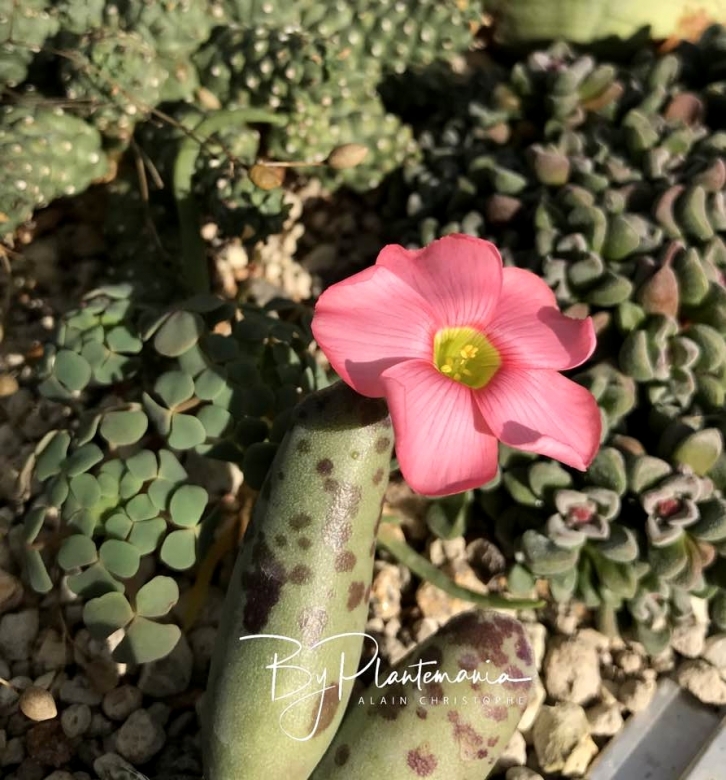




Your support is critical to our success.

Origin and Habitat: Western cape (Karoo and Little Karoo) and Lesotho.
Synonyms:
- Oxalis convexula Jacq.
ENGLISH: Convex-leaved Wood Sorrel
Description: The Convex-leaved Wood Sorrel (Oxalis convexulaSN|34740]]SN|34740]]) is a low growing, stemless or short-stemmed, perennial geophytic herb that grows from a fairly deeply positioned underground bulb, glabrous throughout. The the leaves comprise three roundish convex and succulent leaflets. The rosy-salmon flowers with a yellow throat appear in autumn and winter and may extend to spring. The plant reaches heights of up to 15 cm.
Stem: Shortly subterraneous, then standing out from 7-12 cm long, round, purple, smooth, without scales, the thickness of a pigeon's quill or thicker, wholly procumbent, branched, brittle, with a central tough fibril, thickened at the tip, and from this terminated by a very close and elegant umbel of leaves and flowers.
Bulb: Deeply positioned, oval tapering at both ends, the size of a hazel nut to twice that bigness, blackish brown, smooth.
Leaves: Very numerous, spreading every way, trifoliolate. Leaflets almost circular, toothless or with just a hint of a shallow notch at the tip of especially the middle leaflet, thick and fleshy, sub-convex or flat, punctate on both faces, veinless, paler underneath, 6-8 mm wide and long.
Inflorescences: Flowers grow solitary on fleshy stalks longer than the leaves, bibracteolate above the middle. Petioles 2.5-7.5 cm long. Bracteoles alternate or opposite.
Flowers: Salmon pink to cerise, yellow inside the corolla tube. Calyx 4-6 mm long. Sepals lanceolate, obtuse, mostly with one or two apical calli, ciliolate, less than half to 4 times shorter than the corolla. Corolla 16-24 mm long, with yellowish claw and rosy, white, or pale violet petals that form a funnel-shaped tube, spreading widely at the mouth in five broad lobes with angular to rounded tips. Claws of the petals equalling the lamina or shorter. Fine, slightly darker lines radiate from the centre along the petal surfaces. Styles middling filaments pilose or glandular.
Blooming season: Late autumn, winter and early spring.
Bibliography: Major references and further lectures
1) W. Sonder, "Flora Capensis", Vol 1, 1894
2) Tim Johnson, "CRC Ethnobotany Desk Reference", CRC Press, 11 December 1998
3) Philip Miller, "The Gardener and Botanist's Dictionary: Containing the Best and Newest Methods of Cultivating and Improving the Kitchen, Fruit and Flower Garden ...", F.C. and J. Rivington, 1807
4) Vlok, J. and Schutte-Vlok, A.L. 2010. "Plants of the Klein Karoo", Umdaus Press, Hatfield.
5) Pacificbulbsociety, "South African Oxalis Two", web: http://www.pacificbulbsociety.org/pbswiki/index.php/SouthAfricanOxalisTwo
6) Ivan Latti, "Oxalis convexula", in Operation Wildflowers web: https://www.operationwildflower.org.za/index.php/albums/genera/oxalis/oxalis-convexula-il-1-3743
7) "Encyclopaedia Londinensis, Or, Universal Dictionary of Arts, Sciences, and Literature", Volume 18, publisher not identified, 1821
Cultivation and Propagation: Oxalis convexulaSN|34740]]SN|34740]] is suited for alpine house. Need a dry rest in summer, watering from November
Traditional uses: Beverages and salads
Propagation: Division of resting tubers. Seed in spring, germination 1-3 months at about 18-21°C. The plants also form multiple small bulbils clustered about the axis of the flower stems. These are deposited on the ground below the plants and they produce new plantlets either in spring or in the autumn. If not destroyed, they produce within several months a new crop of flowering specimens.
| Your Actions | |
|---|---|
| Back to Oxalis index | |
| Back to Oxalidaceae index | |
 |
Back to Bulbs Encyclopedia index |
Privacy stantement - Terms and conditions - How to cite - About us - Feedback - Donate


